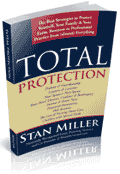Asset Protection Planning
Why work, invest, save and build if it can all be taken from you in an instant by a runaway jury with no stake in the outcome?
We get that sentiment. But you don’t have to incur that risk. Powerful tools are available that can protect what you’ve earned from plaintiff’s lawyers and runaway juries. And those solutions don’t usually require you to give up control over the management of your assets. The solutions are there. Why not use them? Some of those strategies include:
- Strategic use of existing state and federal exemptions
- Limited Partnerships, Limited Liability companies and Limited Liability Limited Partnerships
- Third-party Asset Protection trusts
- Domestic Self-settled trusts
- Offshore trusts
- Bridge Trusts
- Opportunity-shifting, equity stripping and asset isolation strategies
There is a Reason the Demand for Asset Protection is Growing
People sue each other more now. Even in the South and Midwest, people are increasingly willing to take each other to court.
CLICK HERE TO LEARN MORE
No matter how frivolous a lawsuit may appear, juries sometimes bring back large verdicts that are based on emotion more than law. None of us want everything we have worked for and saved to be exposed to the capriciousness of a jury that has no stake in the outcome. We also know that some of the people you love the most may need protection from themselves. They may lack the maturity to handle a large inheritance. They may be in an unstable marriage. They may have a drug or alcohol dependency.
All of this helps explain why, even in the South and Midwest, Asset Protection Planning is such a rapidly growing area of the law and why it is so important for you to have a plan expertly tailored to protect you and the people you care about. Asset Protection Planning is now an essential component of asset planning and asset management. This is particularly true if you are in a profession that is subject to an unusually high number of lawsuits or a high risk business.
At ILP+ McChain Miller Nissman, our Arkansas asset protection lawyers provide the guidance that individuals, families and owners of closely-held companies need in understanding the risks they face. As Asset Protection attorneys, we then design an asset protection strategy to protect against those risks. Collectively, we have over 90 years of experience in all areas of asset protection law, and an extensive network of asset protection professionals world-wide.
Limited Liability Entities and the Power of Charging Order Protection.
A significant level of asset protection can be obtained by transferring assets to one of these entities. The asset protection comes from the “charging order” feature which is a concept that was developed by English common law but which has found its way into almost every state statute.
CLICK HERE TO LEARN MORE
This law provides that a creditor cannot levy on a partner’s interest or a member’s interest. The creditor rights are limited to a legal device called a “Charging Order” which limits the creditor to taking only the distributions that are made to the partner or member.
While these entities do not provide perfect protection, the charging order is a significant impediment to the collection of a judgment–significant enough that it results in a reasonable settlement of the claim even before the lawsuit is filed.
We sometimes use these entities as a stand-alone solution. In other situations, we combine them with one of the trust structures we discuss on this page. This allows our client to transfer the economic interest while retaining the ability to manage the assets.
Domestic Self-Settled Asset Protection Trusts
A domestic asset protection trust is any trust established under the laws of one of the 50 states or U.S. Territories that is established to protect your assets from creditors. The domestic asset protection trust allows the assets to remain in the U.S. under the direct or indirect control of the the person establishing the trust.
CLICK HERE TO LEARN MORE
Since 1997, with the adoption of legislation in Alaska, several U.S. states have adopted legislation similar to various offshore jurisdictions allowing an individual to create a trust for his or her own benefit [generally referred to as a “self-settled” trust]. Traditionally, a self-settled trust had no asset protection in any state in the United States. That is no longer the case. Fifteen states have now passed legislation providing creditor protection to a grantor/beneficiary of an Asset Protection Trust. These states include Alaska, Delaware, Nevada, Rhode Island, Utah, Wyoming, Virginia, South Dakota, Hawaii, Missouri, New Hampshire, Ohio, Oklahoma, Tennessee, and Mississippi. We believe this pattern of recent legislation indicates a strong U.S. trend for providing Asset Protection for individuals establishing self-settled trusts in these jurisdictions.
Questions remain, however, because the courts have had few opportunities to issue rulings in cases arising under this legislation. Depending on the timeline involved with respect to when the claim has arisen, these trusts can be and should be considered in appropriate circumstances, but only by an asset protection attorney who understands all of the ramifications. For Arkansas residents, these issues should be carefully analyzed by an Arkansas asset protection attorney because there are several issues and opportunities that impact the decision to create a self-settled trust.
One issue that impacts Arkansas residents is the availability of certain statutory exemptions or exemptions available under Arkansas’ 1874 Constitution. Arkansas has a comparatively generous homestead exemption, for example.
An asset protection trust is usually structured to be:
- Irrevocable, either permanently or for a term of several years
- Treated as domestic grantor trusts for income and capital gains tax purposes
- Returned to the trust’s creator upon termination
The benefits of a self-settled domestic asset protection trust include:
- Confidentiality of asset ownership
- Serves as a deterrent to litigation
- Allows grantor to be a beneficiary directly without relying on cooperation of family members
- Comparatively inexpensive to establish and to maintain
- Ability to be moved to an offshore jurisdiction when appropriate
While a domestic self-settled asset protection trust provides significant compelling benefits, and is the best option for clients in many situations, it is not always the best asset protection option. It does require the appointment of a trustee in the chosen jurisdiction, and that Trustee is generally a corporate fiduciary that will charge a fee that ranges from $3000 to $6000 each year, and often more if more than routine work is required. Sometimes, a Third Party Asset Protection Trust is a better choice.
Third Party Asset Protection Trusts
Third Party Asset Protection Trusts are attractive options and are the preferred option for most of our clients. This is the least costly of the Asset Protection Trust options to establish and maintain. It has the additional advantage of having the best history of withstanding attack by creditors.
CLICK HERE TO LEARN MORE
Almost every state has long-established “spendthrift” statutes that have been tested many times over many decades, so the law governing these trusts is generally clear. So when the facts are appropriate, the Third Party Asset Protection Trust is an ideal solution. A Third Party Asset Protection Trust is a trust formed by one person for the benefit of another person. For example, a parent could create a Third Party Asset Protection Trust for the benefit of a child. Or one spouse could create a Third Party Asset Protection Trust for the benefit of a spouse. In the latter situation, if the marriage is solid, the couple will generally understand that distributions that are made to the spouse will be shared with the spouse creating the trust. The spouse may also serve as the Trustee or as the Cotrustee of the trust which generally eliminates the need to pay a corporate Trustee to fill that role.
One concern many clients have is the concern that their spouse might become incapacitated or predecease them and thereby cause them to lose any opportunity to have the benefit of the assets in the trust. To address that circumstance, we will generally name a Trust Protector (usually a trusted friend or the attorney) who will be empowered to name the grantor of the trust as an additional beneficiary. Should that need arise, the Trust Protector or the Trustee of the Third Party Asset Protection Trust will need to follow a procedure to “re-situs” the trust in one of the jurisdictions, either in the United States or offshore, that has adopted legislation permitting self-settled trusts.
Offshore Asset Protection Trusts
Many of our clients, and particularly those who consider a Domestic Asset Protection Trust, will also consider the option of an Offshore Asset Protection Trust.
CLICK HERE TO LEARN MORE
For well over a century, individuals in the U.S. have utilized foreign self-settled trusts to protect their assets. Many offshore jurisdictions have enabling legislation or favorable court decisions that provide creditor protection for self-settled trusts. In several offshore jurisdictions, asset protection is the local industry, so these jurisdictions have a huge stake in the trusts created in their jurisdiction working as promised. The real attraction to an Offshore Asset Protection Trust is that the assets in the trust are truly beyond the jurisdiction of an American court. Creditors that obtain a judgment against a client are required to re-litigate their claim in the offshore jurisdiction, and the litigation environment in those jurisdictions is far less creditor-friendly than is the case in courts in the United States. For example, contingency fees to plaintiff’s attorneys are not generally allowed. However, the Offshore Asset Protection Trust model is more costly to establish and maintain than the Third Party Asset Protection Trust or the Domestic Asset Protection Trust.
Bridge Trusts
Our colleague Douglas Lodmell has developed an approach to offshore trust planning that we like. In this video, Doug and ILP + principal Stan Miller discuss this approach Doug calls the “Bridge Trust.” In this approach, a Domestic Asset Protection Trust is established, but an arrangement is immediately made with an offshore trust company, usually in the Cook Islands, that allows the trust to be immediately moved to the offshore jurisdiction if creditors threaten the client. This approach assures easy access to the foreign jurisdiction when its needed, but without most of the expense required to maintain the offshore trust until those costs are actually justified by circumstances.
The Fraudulent Transfer Law
The most frequent obstacle to Asset Protection Planning is the Fraudulent Transfer Law. Anyone thinking about asset protection needs to be aware of this law and how it works.
CLICK HERE TO LEARN MORE
This law provides that a debtor cannot transfer assets if the principal reason for the transfer is to hinder or deter creditors from gaining access to assets. If a court concludes that a debtor engaged in actions with the intention of “delaying, hindering, or defrauding” creditors, the court may set those transfers aside. Normally, in order for the transfer to be classified as fraudulent, the transfer involved, when considered along with the potential amount of the creditor claim, has to make the transferor insolvent. Also, transfers made on an arms-length basis for fair market value are not considered fraudulent transfers.
The consequences of the Fraudulent Transfer Law make it imperative that the business owner or professional implement Asset Protection strategies before a creditor claim arises. Once the facts occur which give rise to the creditor claim, planning is significantly more difficult and the available options are far fewer. However, the experience in our law firm has shown that there are always steps that can be taken that can provide some measure of benefit even if those actions are taken after the claim has arisen.
Our Connections






ILP + The Book

It is possible to protect yourself, your family and your business or professional practice from the real threats that keep you up at night. The law provides more and better solutions than ever before in history. In this book, Stan explains in clear, understandable language how these powerful solutions can be deployed to protect what you have earned and built.
Available Early Summer 2015
ILP + The Webinar

In this hour-long webinar, Stan explains how to avoid probate and protect your heirs with a revocable living trust. You will learn how to protect your loved ones what many consider to be an expensive, lengthy, and unnecessary court process. You will also learn what a living trust is and why having a living trust will protect your children, grandchildren and other heirs.
Available Now









